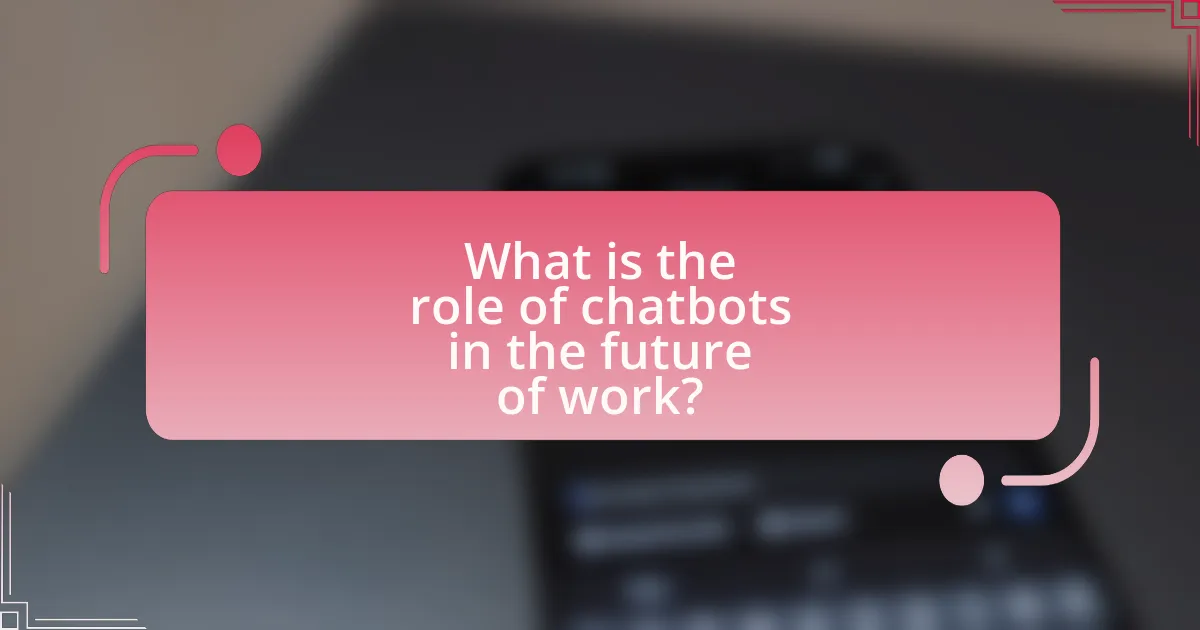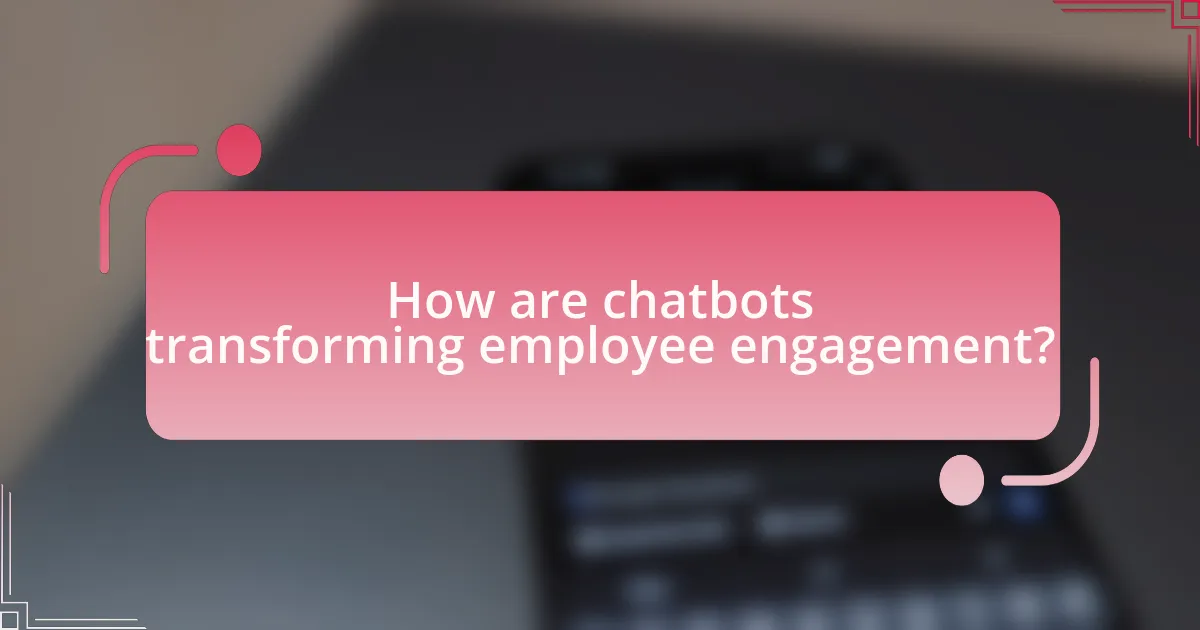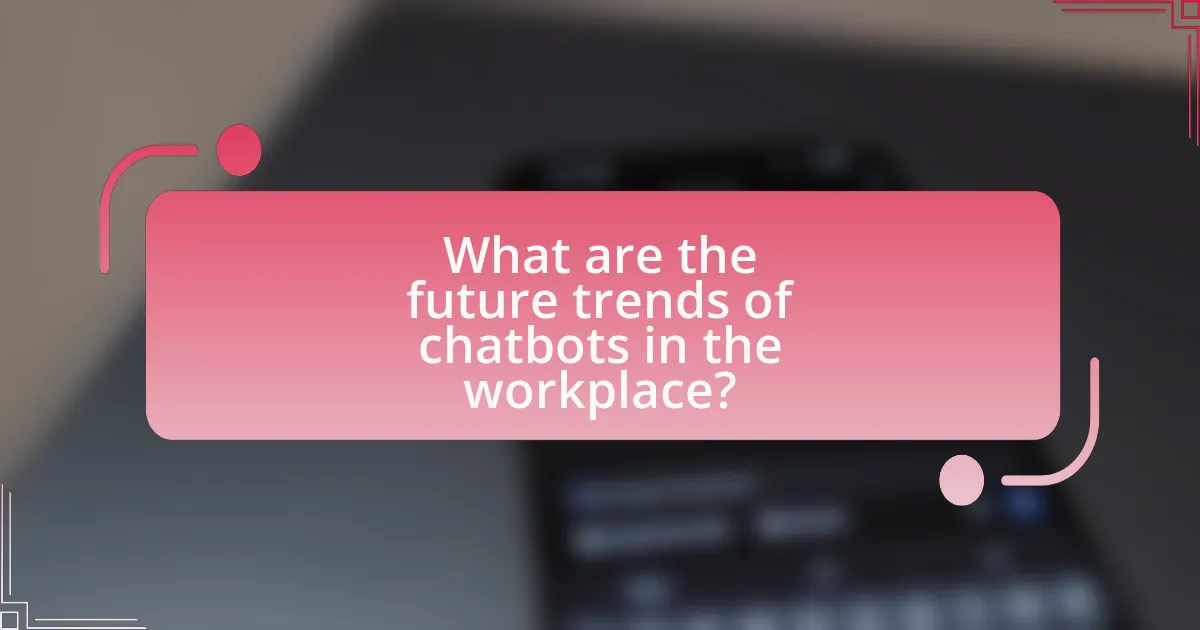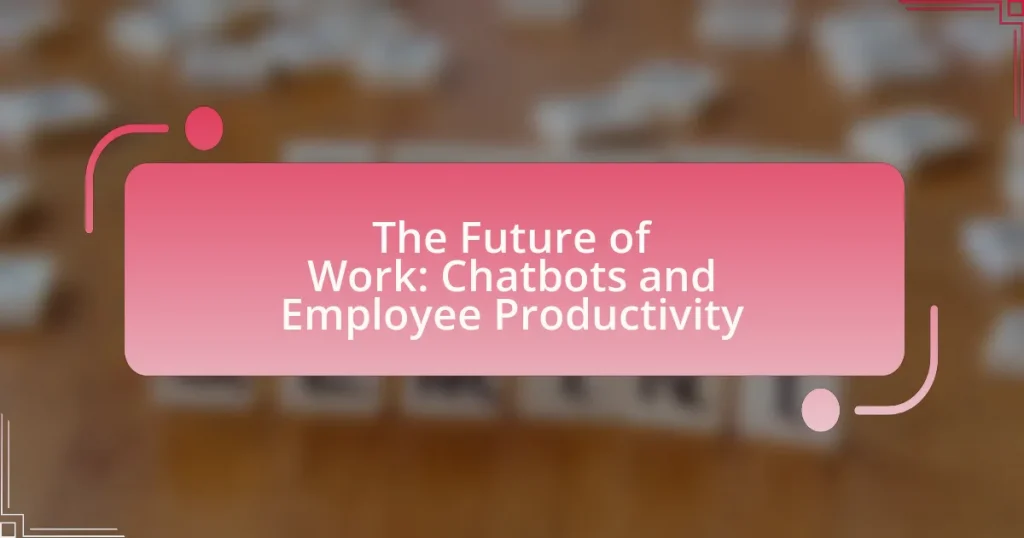The article focuses on the role of chatbots in the future of work, emphasizing their impact on employee productivity and communication. It outlines how chatbots automate routine tasks, enhance team collaboration, and improve employee engagement through instant access to information and personalized interactions. The article also addresses potential challenges in chatbot integration, such as employee resistance and privacy concerns, while highlighting best practices for successful implementation. Additionally, it explores future trends in chatbot technology and the specific industries that stand to benefit the most from their adoption.

What is the role of chatbots in the future of work?
Chatbots will play a crucial role in the future of work by enhancing employee productivity and streamlining communication. These AI-driven tools can automate routine tasks, such as scheduling meetings and answering frequently asked questions, allowing employees to focus on more complex and strategic activities. According to a report by Gartner, by 2025, 75% of customer service interactions will be powered by AI, including chatbots, which indicates a significant shift towards automation in workplace environments. This integration not only improves efficiency but also fosters a more agile work culture, enabling organizations to respond quickly to changing demands.
How do chatbots enhance employee productivity?
Chatbots enhance employee productivity by automating repetitive tasks and providing instant access to information. This automation allows employees to focus on higher-value activities, reducing time spent on mundane inquiries and administrative duties. For instance, a study by Gartner found that chatbots can handle up to 80% of routine customer service interactions, which frees up employees to engage in more complex problem-solving and strategic initiatives. Additionally, chatbots can operate 24/7, ensuring that employees have access to support and resources at any time, further streamlining workflows and improving efficiency.
What specific tasks can chatbots automate for employees?
Chatbots can automate specific tasks such as customer support, appointment scheduling, data entry, and information retrieval for employees. By handling routine inquiries and providing instant responses, chatbots reduce the workload on human staff, allowing them to focus on more complex tasks. For instance, a study by IBM found that chatbots can resolve up to 80% of standard customer queries without human intervention, significantly increasing efficiency and productivity in the workplace.
How do chatbots improve communication within teams?
Chatbots improve communication within teams by providing instant responses and facilitating information sharing. They enable team members to access relevant data quickly, reducing the time spent searching for information. For instance, a study by Gartner indicates that chatbots can handle up to 80% of routine inquiries, allowing employees to focus on more complex tasks. Additionally, chatbots can streamline communication by integrating with various collaboration tools, ensuring that all team members are on the same page and reducing the likelihood of miscommunication. This efficiency in communication ultimately enhances overall team productivity and collaboration.
What are the potential challenges of integrating chatbots in the workplace?
The potential challenges of integrating chatbots in the workplace include resistance from employees, technical limitations, and concerns about data privacy. Employees may resist adopting chatbots due to fear of job displacement or skepticism about their effectiveness, which can hinder successful implementation. Technical limitations, such as inadequate natural language processing capabilities, can lead to misunderstandings and frustration among users. Additionally, concerns about data privacy arise as chatbots often handle sensitive information, necessitating robust security measures to protect user data and comply with regulations. These challenges highlight the complexities involved in effectively integrating chatbots into workplace environments.
How can resistance to change affect chatbot implementation?
Resistance to change can significantly hinder chatbot implementation by creating barriers to user acceptance and engagement. When employees are resistant, they may not utilize the chatbot effectively, leading to underperformance of the technology. Studies indicate that organizations with high resistance to change experience a 70% failure rate in technology adoption, as employees often prefer established workflows over new systems. This reluctance can result in inadequate training, poor integration with existing processes, and ultimately, a failure to achieve the intended productivity gains from the chatbot.
What are the privacy concerns associated with chatbot usage?
Privacy concerns associated with chatbot usage include data security, user consent, and potential misuse of personal information. Chatbots often collect sensitive data, such as personal identifiers and conversation histories, which can be vulnerable to breaches. For instance, a 2020 report by the Ponemon Institute found that 60% of organizations experienced a data breach involving customer data, highlighting the risks associated with inadequate security measures. Additionally, users may not be fully aware of how their data is being used or shared, raising ethical concerns about consent and transparency. Furthermore, the potential for chatbots to be exploited for phishing attacks or to manipulate user behavior poses significant risks to individual privacy.

How are chatbots transforming employee engagement?
Chatbots are transforming employee engagement by providing instant access to information and support, which enhances communication and reduces response times. These AI-driven tools facilitate real-time interactions, allowing employees to quickly resolve queries related to HR policies, benefits, and company resources. According to a report by Gartner, organizations that implement chatbots can improve employee engagement scores by up to 30% due to increased accessibility and streamlined processes. Furthermore, chatbots can gather feedback and insights from employees, enabling companies to address concerns proactively and foster a more inclusive workplace culture.
What features of chatbots contribute to better employee engagement?
Chatbots enhance employee engagement through features such as instant communication, personalized interactions, and 24/7 availability. Instant communication allows employees to receive immediate responses to queries, reducing frustration and increasing satisfaction. Personalized interactions, driven by AI, tailor responses based on individual employee needs and preferences, fostering a sense of recognition and value. The 24/7 availability of chatbots ensures that employees can access support and information at any time, promoting a more flexible work environment. According to a study by Gartner, organizations that implement chatbots for employee engagement see a 30% increase in employee satisfaction, demonstrating the effectiveness of these features in enhancing workplace morale and productivity.
How do chatbots provide personalized experiences for employees?
Chatbots provide personalized experiences for employees by utilizing data-driven insights to tailor interactions and responses based on individual preferences and needs. These AI-driven tools analyze employee data, such as past interactions, job roles, and specific queries, to deliver customized support and information. For instance, a study by IBM found that organizations using chatbots for employee engagement reported a 30% increase in satisfaction due to the personalized assistance provided. This capability allows chatbots to enhance productivity by streamlining workflows and offering relevant resources, ultimately fostering a more engaged and efficient workforce.
What role do chatbots play in employee feedback and surveys?
Chatbots play a crucial role in employee feedback and surveys by automating data collection and enhancing engagement. They facilitate real-time communication, allowing employees to provide feedback conveniently and anonymously, which increases response rates. According to a study by Gartner, organizations that utilize chatbots for employee engagement can see a 30% increase in participation in surveys compared to traditional methods. Additionally, chatbots can analyze responses instantly, providing employers with actionable insights and trends, thereby streamlining the feedback process.
How can chatbots support remote work environments?
Chatbots can support remote work environments by providing instant communication, automating routine tasks, and facilitating access to information. They enhance team collaboration by enabling quick responses to queries, which reduces delays in decision-making. For instance, a study by Gartner found that 70% of white-collar workers will interact with conversational platforms daily by 2022, indicating a significant shift towards reliance on chatbots for efficiency. Additionally, chatbots can handle repetitive tasks such as scheduling meetings or managing project updates, allowing employees to focus on more strategic work. This automation leads to increased productivity, as reported by a McKinsey study, which states that automation can boost productivity by up to 40% in certain sectors.
What tools do chatbots offer to facilitate remote collaboration?
Chatbots offer several tools to facilitate remote collaboration, including real-time communication, task management, and integration with other software applications. These tools enable teams to communicate instantly through messaging platforms, assign and track tasks efficiently, and connect with productivity tools like calendars and project management software. For instance, chatbots can automate reminders for deadlines and meetings, ensuring that team members stay aligned on their responsibilities. Additionally, studies show that organizations using chatbots for collaboration report a 30% increase in team productivity, highlighting their effectiveness in enhancing remote work dynamics.
How do chatbots help in managing remote employee performance?
Chatbots assist in managing remote employee performance by providing real-time feedback and facilitating communication between employees and management. They can track employee progress on tasks, answer queries instantly, and deliver performance metrics, which helps in identifying areas for improvement. For instance, a study by Gartner found that organizations using chatbots for employee engagement reported a 30% increase in productivity due to enhanced communication and timely feedback. This data underscores the effectiveness of chatbots in optimizing remote work performance.

What are the future trends of chatbots in the workplace?
The future trends of chatbots in the workplace include increased integration with artificial intelligence, enhanced personalization, and improved natural language processing capabilities. As organizations seek to streamline operations, chatbots will leverage AI to provide more accurate responses and automate complex tasks, thereby increasing efficiency. According to a report by Gartner, by 2025, 75% of customer service interactions will be powered by AI, indicating a significant shift towards chatbot utilization in various workplace functions. Additionally, chatbots will become more personalized, utilizing data analytics to tailor interactions based on employee preferences and behaviors, which can lead to higher engagement and satisfaction. Enhanced natural language processing will allow chatbots to understand and respond to nuanced queries, making them more effective in assisting employees with their tasks.
How will advancements in AI impact chatbot capabilities?
Advancements in AI will significantly enhance chatbot capabilities by improving their understanding of natural language and enabling more personalized interactions. Enhanced natural language processing (NLP) algorithms will allow chatbots to comprehend context, sentiment, and nuances in human conversation, leading to more accurate and relevant responses. For instance, AI models like OpenAI’s GPT-3 have demonstrated the ability to generate human-like text, which can be integrated into chatbots to facilitate seamless communication. Additionally, machine learning techniques will enable chatbots to learn from user interactions over time, improving their performance and adaptability. This evolution in AI technology will ultimately lead to chatbots that can handle complex queries, provide tailored recommendations, and support employees more effectively, thereby increasing overall productivity in the workplace.
What new functionalities can we expect from future chatbots?
Future chatbots are expected to incorporate advanced functionalities such as enhanced natural language understanding, emotional intelligence, and multi-modal interaction capabilities. Enhanced natural language understanding will allow chatbots to comprehend context and nuances in conversations better, improving user experience. Emotional intelligence will enable chatbots to recognize and respond to user emotions, fostering more personalized interactions. Multi-modal interaction capabilities will allow chatbots to engage users through various formats, including text, voice, and visual elements, making them more versatile in communication. These advancements are supported by ongoing research in AI and machine learning, which continuously improve chatbot performance and user engagement.
How will chatbots evolve to meet changing workforce needs?
Chatbots will evolve to meet changing workforce needs by integrating advanced artificial intelligence and machine learning capabilities, enabling them to provide personalized support and automate complex tasks. As businesses increasingly adopt remote and hybrid work models, chatbots will enhance communication and collaboration by facilitating real-time information sharing and task management. For instance, a study by Gartner predicts that by 2025, 75% of customer service interactions will be powered by AI, indicating a significant shift towards automation in workforce support. This evolution will allow chatbots to adapt to diverse employee requirements, streamline workflows, and improve overall productivity in the workplace.
What industries are likely to benefit most from chatbot integration?
The industries likely to benefit most from chatbot integration include customer service, e-commerce, healthcare, and finance. Customer service can enhance efficiency and response times, as chatbots handle routine inquiries, allowing human agents to focus on complex issues. In e-commerce, chatbots facilitate 24/7 customer support and personalized shopping experiences, which can lead to increased sales; for instance, a study by Juniper Research estimates that chatbots will save businesses over $8 billion annually by 2022. Healthcare can utilize chatbots for appointment scheduling and patient inquiries, improving patient engagement and operational efficiency. In finance, chatbots assist with customer queries and transaction processing, streamlining operations and enhancing user experience. These industries demonstrate significant potential for productivity gains and cost savings through effective chatbot integration.
How are chatbots being utilized in customer service sectors?
Chatbots are utilized in customer service sectors to automate responses to customer inquiries, enhancing efficiency and reducing wait times. By employing natural language processing, chatbots can understand and respond to common questions, allowing human agents to focus on more complex issues. For instance, a study by Gartner indicates that by 2022, 70% of customer interactions will involve emerging technologies like chatbots, demonstrating their growing role in streamlining customer service operations.
What role do chatbots play in the healthcare industry?
Chatbots play a significant role in the healthcare industry by enhancing patient engagement and streamlining administrative processes. They provide immediate responses to patient inquiries, assist in appointment scheduling, and offer medication reminders, which improves overall patient satisfaction and adherence to treatment plans. According to a study published in the Journal of Medical Internet Research, chatbots can handle up to 80% of routine inquiries, allowing healthcare professionals to focus on more complex cases. This efficiency not only reduces wait times but also lowers operational costs for healthcare facilities, demonstrating the tangible benefits of integrating chatbots into healthcare systems.
What best practices should organizations follow when implementing chatbots?
Organizations should follow several best practices when implementing chatbots to ensure effectiveness and user satisfaction. First, they must clearly define the chatbot’s purpose and scope, aligning it with specific business goals, such as improving customer service or streamlining internal processes. This clarity helps in designing relevant interactions and functionalities.
Next, organizations should invest in user-friendly design and natural language processing capabilities to enhance user experience. A study by Gartner indicates that 70% of customer interactions will involve emerging technologies like chatbots by 2022, emphasizing the need for intuitive interfaces that facilitate seamless communication.
Additionally, continuous training and updating of the chatbot are crucial. Organizations should regularly analyze user interactions to identify areas for improvement and refine the chatbot’s responses based on real user feedback. According to a report from McKinsey, companies that actively manage and optimize their AI systems can achieve up to 20% higher productivity.
Finally, integrating the chatbot with existing systems and ensuring data security are essential to maintain operational efficiency and protect user information. By adhering to these best practices, organizations can maximize the benefits of chatbot implementation and enhance overall productivity.
How can organizations ensure successful chatbot adoption among employees?
Organizations can ensure successful chatbot adoption among employees by providing comprehensive training and ongoing support. Effective training programs equip employees with the necessary skills to utilize chatbots efficiently, leading to increased confidence and usage rates. Research indicates that organizations that invest in training see a 30% higher adoption rate compared to those that do not. Additionally, continuous support through feedback mechanisms and updates fosters a culture of engagement and improvement, further enhancing the likelihood of successful integration into daily workflows.
What metrics should be used to measure chatbot effectiveness in the workplace?
To measure chatbot effectiveness in the workplace, key metrics include user satisfaction, response accuracy, resolution time, and engagement rate. User satisfaction can be gauged through post-interaction surveys, revealing how well the chatbot meets employee needs. Response accuracy assesses the chatbot’s ability to provide correct information, which is crucial for maintaining trust and efficiency. Resolution time measures how quickly the chatbot resolves queries, impacting overall productivity. Engagement rate indicates how often employees interact with the chatbot, reflecting its usefulness and integration into daily tasks. These metrics collectively provide a comprehensive view of a chatbot’s performance and its contribution to workplace productivity.










